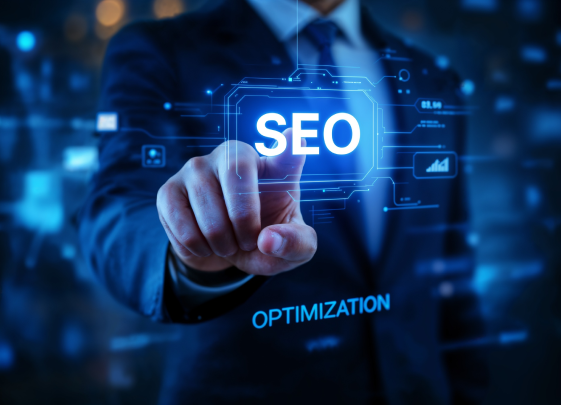What is SEO in Marketing?
Nowadays, businesses want themselves to be discovered by more and more people. To do that, they must appear on the search engine top lists, As the first approach for most people today is to search on any search engine. This is where SEO comes into play.
- December 2, 2024
- by Tarun


Why Do We Need SEO in Marketing?
75% of people will never scroll past the first page of search results. In and of itself, that’s proof positive that ranking well is essential for getting online exposure. Meanwhile, over 54.4% of all clicks go to the first three organic search results; therefore, top positions are gold. When it comes to marketing your business, SEO nowadays has become an inevitable part of it. It helps you get discovered by the target audience, paving the way for increased reach and revenue.
What is SEO?
It is a combination of techniques that help you rank higher on any search engine. For instance, when you type any query on Google/Bing, you see many results that match your query. SEO determines which website will appear on the first page. You can also think of this as a library where SEO works as an organizing system and the librarian where, among billions of web pages, SEO will guide you toward the top matches.
It is not a good visitor but the right visitor. Quality SEO practices will ensure that people who are ready for your products, services, or information can easily find you, which makes SEO one of the most cost-effective marketing strategies available.
Role of SEO in Marketing
SEO is one of the most effective marketing strategies which focuses mainly on increasing the business reach. Most of the SEO techniques revolve around improving user experience to help in:
- It helps in increasing traffic to your site by placing you at the top of the search engine.
- SEO boosts brand awareness as more people start discovering you through an increase in traffic.
- Optimized website content helps you improve the user experience.
- As most visitors that come to your site are looking for the product/service, it is most likely to convert into sales.
SEO is only focused on Google
Most people think that SEO is used for maintaining a top position on Google only, while SEO heavily focuses on Google but is not limited to it. SEO is more than ranking only on Google it also focuses on other search engines.
The reason most of the activities are heavily focused on Google is that it is a dominant search engine. Most people use Google to search for anything they need which makes it important for any business to rank on Google to get discovered.
Want to rank on the top of Google, here are 10 SEO techniques to improve Google rankings.
Types of SEO in Marketing
On-Page SEO
These are the changes that are made directly on the elements of a website to help you rank higher. These elements include:
Content Quality
The quality and relevant content remain at the centre of any worthwhile SEO. Search engines favour content that gives value to the user. That is to say:
- The article must be well-rounded, researched, and planned articles.
- Solve a particular need or answer to a question for the users.
- Write properly formatted with readability in mind
- Updating it frequently to keep new and updated
Keyword Optimization
Keywords are the link between what people are looking for and your content. However, most people do not think about keyword stuffing anymore. Today’s keyword optimization involves the following:
- Strategic placement in titles, headers and throughout the content
- Use of related terms and synonyms in a natural flow
Understanding what is being searched for when they input a term into the search
- Long-tail keywords for a specific query
Meta Elements
These are the HTML elements that you should use to tell the search engines what your content is about:
- Title tag: Being imaginative with keyword-rich titles not exceeding 60 characters.
- Meta Description: Clear summaries of page content under 160 characters.
- Header tags: Proper hierarchical structure (H1, H2, H3).
- Image alt text: Descriptions for images.
Technical SEO
These are behind-the-scenes improvements on your site that are not related to the content designed to improve SEO. These Improvements Include:
Site Structure
The structure of the website should be well organized to help both search engines and users navigate to your site. It should follow:

- The navigation should be clean and logical
- The internal linking should be precise
- Create a proper XML Sitemap to allow Google to crawl all pages on your site
- Optimize the Robot.txt file to notify search engines which URL can be accessed.
Page Speed
The loading time of a page significantly impacts the user experience as well as ranking. Make sure to:
- Optimize all the images
- Turn on Browser Caching
- Proper minification of your code
- Optimize the response time from the server
Mobile Optimization
Now, search engines prefer mobile-first design, which makes it important to make your website mobile-friendly. These are some points to take care of:
- Responsive Design
- All elements should be touch-friendly
- All the fonts should be of appropriate size for the user
- All the elements should contain proper spacing to avoid mistaken touches.
Need Technical SEO guidance and support to boost your website rankings?
Our Experts Can Help!
Off-Page SEO
These are the factors that affect the ranking and authority of your website significantly. These include:
Backlinks
Quality backlinks are like “votes of confidence” from other websites
- Quality link building through creating valuable content
- Guest post on authority sites
- Building good relationships with an influencer in your niche
- Get Citations for your local business
Social media
While this is not a direct factor for ranking, having a presence on social media can significantly improve the visibility of your brand. You can use social media for:
- Engagement with your follower
- Sharing your content
- Get brand mentions from influencers
- Manage your online reputation
Advance SEO Strategies
Local SEO
If your business is located in a specific geographical area, you need to focus on Local SEO to make it Discoverable to the local population.

Optimizing Google Business Profile
- Make sure all the information present in the Google My Business listing is correct and up to date.
- Post new updates at regular intervals
- Properly manage the customer review
- Integrate local keywords in your business profile.
Add a CTA: Don’t have a Google My Business account, here’s how to create a Google My Business account.
Local Content Creation
- Make sure to create and add area-specific landing pages to your site.
- You can also take part in local events and cover the events.
- Create Content that involves the local community
- Post news and updates in your region regularly.
Ecommerce SEO
To make sales on ecommerce platforms a customized SEO approach is required.

Product Page Optimization
- Create a unique description of each product.
- Use high-quality images for each product.
- Make sure to integrate customer reviews to allow new customers to know what people think of your product.
- Implement schema markup to make sure the search engine understands the content of your pages.
Category Page Optimization
- Create a unique description that provides maximum information about the category.
- Implement filtering and sorting to make sure customers can find what they are looking for
- Make sure important information can be found within three clicks by optimizing the internal linking structure.
- Implement Breadcrumb navigation to allow customers to know their location on the website.
Want to increase sales during this holiday season? Here are 20 Ecommerce marketing strategies to help you.
Common SEO Marketing Mistakes
While it is important to know what you need to do, knowing what you should not do is also as important. Here are a few common mistakes:
Poor Content Quality
Just writing new content is not good enough, the quality of the content also matters make sure:
- Not to use duplicate content to avoid plagiarism issues
- Do not create thin content pages, these are pages with no authentic content and a heavy word count.
- Avoid keyword stuffing in your content.
Technical Issues
Technical SEO is very complex, so make sure to:
- Fix all the broken links, as when the search engine crawler finds broken links on your site it negatively impacts the ranking.
- Page loading speed affects both user experience and Google ranking
- If the website is not properly optimized for mobile it also lowers the ranking
- Search engines have difficulty crawling a site when redirect chains are not implemented correctly.
Bad Link Building
Getting links from sites that violate the policies of Google also lowers the search engine ranking. Here are a few activities that come under broken link building:
- Buying links from low-ranking and irrelevant websites
- Participating in link schemes violates the Google guidelines for search.
- Links created with the help of automated tools are irrelevant.
- Doing Directory submissions on irrelevant sites.
Conclusion
SEO is an important part of marketing that needs continuous attention and adaptation. Success in SEO is possible through a combination of technical aspects, content quality, and strategic thinking. Using best practices, avoiding frequent mistakes, and staying updated with current industry trends can build a strong online presence and drive clients to retain them.
The best SEO strategies follow changes in search engine algorithms while constantly focusing on providing value for the user. When businesses invest in SEO, they develop a sustainable source of organic traffic that continues to deliver results in the long term.
The only way to win with SEO is to ensure that you have optimized technically while also making sure that it’s good for users. It’s all about ensuring best practices when it comes to SEO, but remember, you’ve got a goal, and this is adding value to your audience. That means producing quality, relevant content and maintaining technical excellence, and then search rankings will automatically follow.



















